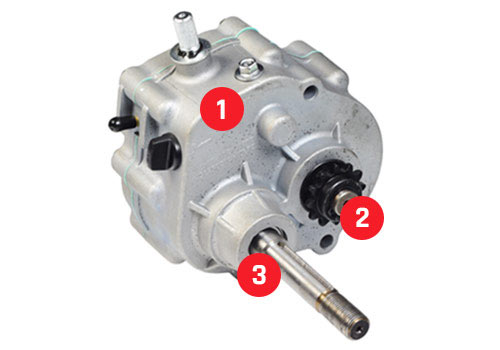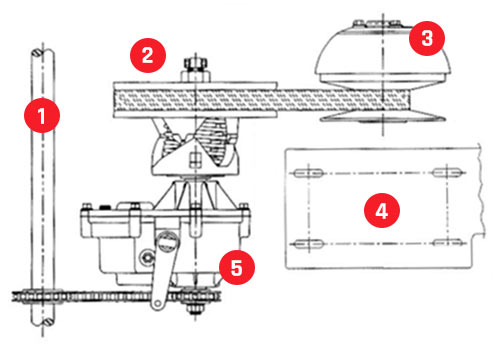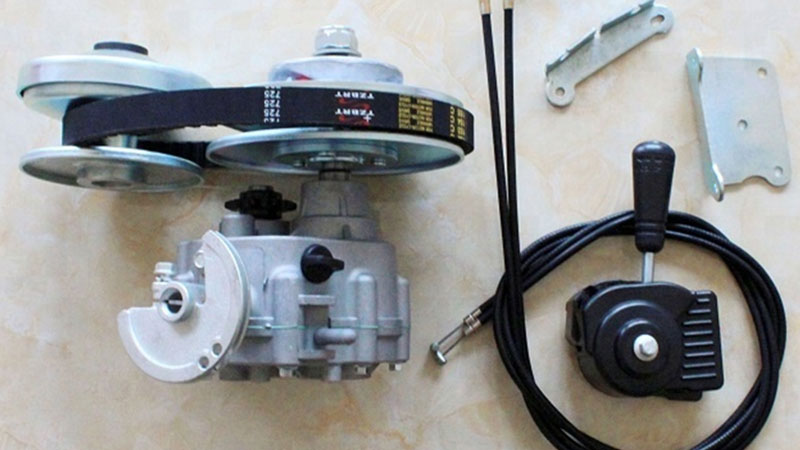When it comes to go-kart racing, we’re mostly focused on stepping on the accelerator and crossing the finish line. Even for off-road go-karting, most of the attention is on driving “full-steam ahead” on uneven terrain.
However, one thing that is often disregarded is the ability of going backwards. In order to do that, you’ll need a reverse gearbox. A reverse gearbox is a transmission that you install between the rear axle and the transmission.
In this guide, we’ll go through a simple 6-step process on how to install a reverse gearbox on your go-kart. Before we do that, let’s first get an understanding of what reverse gearboxes are and how they work.
What is a Go-Kart Reverse Gearbox?
A reverse gearbox is a mechanical component that is connected to the transmission (most commonly a torque converter) and rear axle of a go-kart. The input shaft of the reverse gearbox connects to the driven pulley of the torque converter, whereas the output shaft connects to the rear axle via a sprocket and a chain.
Reverse Gearbox Kit
- Compatible with 30 Series Torque Converter
- Forward Gear Ratio: 1:1.3
- Reverse Gear Ratio: 1:2.6
Once correctly installed, a reverse gearbox will allow you to not only drive your kart forward, but also backward. Take note that electric go-karts don’t require a reverse gearbox, as the reversing function is handled by a speed controller instead.
When to Consider installing a Reverse Gearbox on a Go-kart
Installing a reverse gearbox on your go-kart is not a requirement, but rather a matter of convenience and application. Racing go-karts typically don’t have a reverse gearbox, as these types of go-karts are designed to be as lightweight as possible.
When they are required to be moved backwards, they can be simply pushed in that direction. On the other hand, reverse gearboxes are more common on off-road and homemade go-karts.
A reverse gearbox will enable you to get out of sticky situations such as being stuck in certain terrain, wanting to back out of a narrow path and several other scenarios.
There are certainly several benefits to installing a gearbox on your go-kart.
How does a Reverse Gearbox Work on a Go-Kart?
The reverse gearbox has an input and an output shaft. The input shaft is connected either directly with the engine or to a clutch or a torque converter. The rotation of the engine crankshaft rotates the input shaft on the gear box (or the torque converter if a transmission is installed).

Gearbox Description:
- Gearbox Housing
- Output Shaft (with Sprocket)
- Input Shaft
Inside the gearbox are cog wheels that connect the input shaft with the output shaft. Engaging the reverse gear will enable the output shaft to rotate in the opposite direction, meaning that the rear axle will be spun counterclockwise.
This will enable the go-kart to move in a backward direction. In order to move forward again, the reverse gear would need to be disengaged.
Install a Reverse Gearbox on Your Go-Kart in 6 Steps
Installing a reverse gear on a go-kart, can seem like a very daunting task. While it does require several tools and some intermediate understanding of how several components work, the instructions are fairly straight forward.
Before starting your process, ensure that you have a good understanding of how go-karts work and also that you have enough space and the right tools.
1. Create Room in The Engine Area for the Reverse Gearbox
To get a better idea of the reverse gearbox setup, you should take a look at the illustration below. You’ll see the location of the engine, axle, driven pulley, driver pulley and the reverse gearbox. Take note on how each of these components are connected with each other.

Reverse Gearbox Setup:
- Rear Axle
- Driven Pulley
- Driver Pulley
- Engine
- Reverse Gearbox
It’s important to note that you can also set up a reverse gearbox if you’re not running a torque converter. Instead of the driven pulley, the input shaft of the reverse gearbox would connect with the go-kart clutch instead (more complicated setup). In some instances, the reverse gearbox would replace the jackshaft on your go-kart.
The first action to take is to create enough room in your engine area to place your reverse gearbox. Please be cautious with this step so you don’t damage anything.
Depending on the size of your go-kart and its engine area, you may be required to move the engine and the torque converter or clutch. It’s always best to leave the axle in its current position.
Before you move the engine, ensure that you know which reverse gearbox you’re going to purchase. The Mophorn Reverse Gearbox for Go-Karts is a great choice for 2 – 7 hp engines and comes with 3 gears (forward, reverse and neutral). Please note that this gearbox only works with 30 Series torque converters.
Firstly, remove the torque converter/clutch and belts/chains. Then loosen the bolts holding the engine down. You’ll need to use the right tools to remove the bolts, so you don’t wear them out.
When you’ve loosened all the fasteners, the engine is now ready to be adjusted. Gently shift it around to create room for the reverse gearbox.
Important Tip: Lay out all the components first before deciding on mounting locations. This will save you a lot of headache, if one part doesn’t fit in properly.
2. Mount the Engine and Reinstall the Torque Converter
Now that you have laid out all of the components correctly, it’s time to mount the engine to its new position. Depending on your go-kart setup, you may need to install brackets so that your engine is securely held in place.
Another great option is a slotted plate. This enables you to move and adjust the engine position by simply drilling holes into the plate that will hold your go-kart engine in place.
After mounting the engine in place, it’s time to install the torque converter. Ensure that the torque converter is tight and that all of its components are set in place.
3. Setup the Reverse Gearbox
Before you mount the gearbox in place, you must ensure that it’s properly set up. This task involves lining up all shafts, adding lubricants to the gearbox and installing bearings, as well as the sprocket.
As your reverse gearbox is a new component to your go-kart setup, take note of the important points below.
- The reverse gearbox should be mounted tightly onto a bracket or plate.
- The gearbox input shaft is connected to the driven pulley of the torque converter (usually with a bearing)
- The gearbox output shaft is connected to the rear axle via a sprocket (usually included in the gearbox kit)
- Add gearbox lubricant to the gearbox (follow gearbox instruction manual)
- Ensure that all shafts are fully aligned and parallel
- Install the chain that connects the rear axle to the gearbox (check tension)
4. Mount the Reverse Gearbox in Place
Once you’ve set up the reverse gearbox correctly, it’s now time to mount it in place. Similar to mounting the reverse gearbox, you’ll need to ensure that it has a solid base that is secure. You can either opt for a bracket or a slotted plate.
A slotted plate is more convenient, as you can easily do position corrections and if you replace or upgrade certain components, you can always mount the gearbox to a different location on the plate.
Some reverse gearbox kits for go-karts already come with mounting plates. They also allow you to adjust the gearbox positions for chain tension optimization.
It’s also important to take note that your reverse gearbox should be mounted to your go-kart horizontally. Failing to do so could wear it out prematurely. You can easily achieve this by using a spirit level or bubble level ruler.
5. Install All Other Gearbox Kit Components
If you’ve purchased a reverse gearbox kit, you should now install some of the components that it came with. These components are typically the gearbox lever (to select the gears), the gearshift disc and two transmission lines.
You’ll need to run them through the frame of your go-kart and install them in a position where you can easily reach the lever.
Before installing the gear lever and transmission lines, it’s best to sit in your seat and find a suitable mounting location. The most common positions for the gear lever are to either side of the seat or next to the steering column.
6. Test the Reverse Gearbox
Now, all that’s left is to test your setup. Keep in mind that each gearbox has different gear ratios. These ratios depend on the reverse gearbox, so take note of it before your purchase.
Here are the most common reverse gearbox ratios:
- Forward Gear Ratio: 1:1.3
- Reverse Gear Ratio: 1:2.6
So when you test your setup, it shouldn’t come to a surprise that your go-kart doesn’t reverse as fast as it goes forward. Once, you’ve tested your new setup, you’re all set!
Congratulations, you’ve successfully installed a reverse gearbox on your go-kart!
Conclusion
Installing a reverse gearbox is a great way to equip your go-kart with a forward, backward and neutral gear. If you decide on installing one, it’s almost always better to get a complete kit.
A reverse gearbox kit for go-karts contains all required parts for installation and will save you plenty of time compared to sourcing each part individually. I hope that this installation guide has helped you and provided you with all the information you needed!


